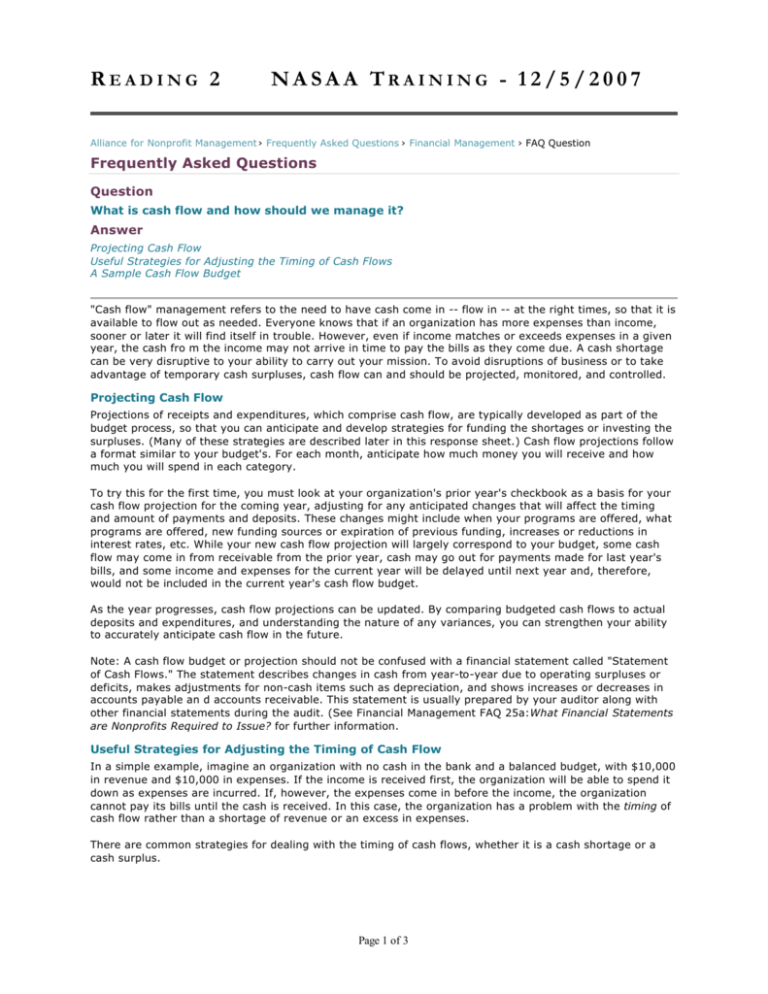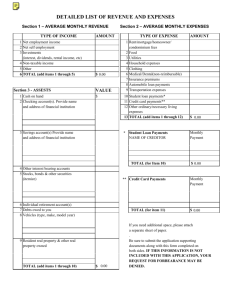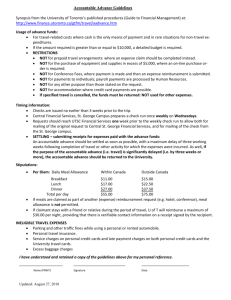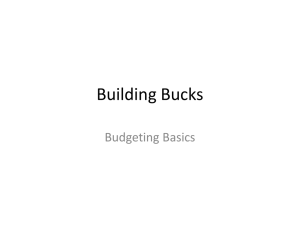READING 2 - What is cash flow and how should we manage it.…
advertisement

READING 2 NASAA TRAINING - 12/5/2007 Alliance for Nonprofit Management › Frequently Asked Questions › Financial Management › FAQ Question Frequently Asked Questions Question What is cash flow and how should we manage it? Answer Projecting Cash Flow Useful Strategies for Adjusting the Timing of Cash Flows A Sample Cash Flow Budget "Cash flow" management refers to the need to have cash come in -- flow in -- at the right times, so that it is available to flow out as needed. Everyone knows that if an organization has more expenses than income, sooner or later it will find itself in trouble. However, even if income matches or exceeds expenses in a given year, the cash fro m the income may not arrive in time to pay the bills as they come due. A cash shortage can be very disruptive to your ability to carry out your mission. To avoid disruptions of business or to take advantage of temporary cash surpluses, cash flow can and should be projected, monitored, and controlled. Projecting Cash Flow Projections of receipts and expenditures, which comprise cash flow, are typically developed as part of the budget process, so that you can anticipate and develop strategies for funding the shortages or investing the surpluses. (Many of these strategies are described later in this response sheet.) Cash flow projections follow a format similar to your budget's. For each month, anticipate how much money you will receive and how much you will spend in each category. To try this for the first time, you must look at your organization's prior year's checkbook as a basis for your cash flow projection for the coming year, adjusting for any anticipated changes that will affect the timing and amount of payments and deposits. These changes might include when your programs are offered, what programs are offered, new funding sources or expiration of previous funding, increases or reductions in interest rates, etc. While your new cash flow projection will largely correspond to your budget, some cash flow may come in from receivable from the prior year, cash may go out for payments made for last year's bills, and some income and expenses for the current year will be delayed until next year and, therefore, would not be included in the current year's cash flow budget. As the year progresses, cash flow projections can be updated. By comparing budgeted cash flows to actual deposits and expenditures, and understanding the nature of any variances, you can strengthen your ability to accurately anticipate cash flow in the future. Note: A cash flow budget or projection should not be confused with a financial statement called "Statement of Cash Flows." The statement describes changes in cash from year-to-year due to operating surpluses or deficits, makes adjustments for non-cash items such as depreciation, and shows increases or decreases in accounts payable an d accounts receivable. This statement is usually prepared by your auditor along with other financial statements during the audit. (See Financial Management FAQ 25a:What Financial Statements are Nonprofits Required to Issue? for further information. Useful Strategies for Adjusting the Timing of Cash Flow In a simple example, imagine an organization with no cash in the bank and a balanced budget, with $10,000 in revenue and $10,000 in expenses. If the income is received first, the organization will be able to spend it down as expenses are incurred. If, however, the expenses come in before the income, the organization cannot pay its bills until the cash is received. In this case, the organization has a problem with the timing of cash flow rather than a shortage of revenue or an excess in expenses. There are common strategies for dealing with the timing of cash flows, whether it is a cash shortage or a cash surplus. Page 1 of 3 • Meeting a Projected Temporary Cash Shortage In order to meet a projected temporary cash shortage, you may want to consider any of the following strategies: • • Obtain a loan, usually from a bank or an individual such as a board or staff member. • Arrange for a line of credit from a bank. • Speed up the collection of receivables (money owed to you). • Move up the fundraising event or campaign you are planning. • Finance the purchase of equipment by leasing it or paying for it over time. • Liquidate investments. • Delay payments to vendors. This strategy is commonly followed in the corporate sector. Nonprofits are often reluctant to delay payments for fear of damaging the public trust or disappointing the vendor, who may be another small business person in the neighborhood. When you must delay payments to vendors, it is often advisable to explain the situation to them carefully, and let them know when they will be paid and how much will each payment be. You may even consider alerting vendors that bills incurred at certain times of year will always be paid. For example, you may experience a cash flow shortfall during the summer. You could negotiate up front with vendors that bills will be paid within thirty days during most of the year, but within ninety days during the summer. Taking Advantage of a Projected Temporary Cash Surplus To take advantage of a projected temporary cash surplus, your organization may: • Make short term investments in certificates of deposit, money market funds, or U.S. Treasury Bonds. • Buy supplies on sale that you will use over the course of the year. In addition to reviewing your organization's revenue and expense budget, the board should review the organization's cash flow budget. The review should also include any measures related to managing cash flow which involve commitments on the part of your organization such as loans or revised terms with vendors. The Helpful Organization: Sample Cash Flow Budget Total Budget January February March April May June 12,000 4,000 16,000 7,500 15,000 EXPECTED REVENUES Gvmt Grants $35,000 Foundation Grants 50,000 Individuals 12,000 Fees for Service 55,000 3,000 4,500 4,500 5,000 5,000 3,000 Total Revenue 152,000 3,000 9,500 6,000 24,500 24,000 49,000 5,000 1,500 Page 2 of 3 30,000 EXPECTED REVENUES Salaries & Fringe Benefits Executive Director 38,000 3,167 3,167 3,167 3,167 3,167 3,167 Program Directors 50,000 4,167 4,167 4,167 4,167 4,167 4,167 Secretary 27,000 2,250 2,250 2,250 2,250 2,250 2,250 Rent 12,000 1,000 1,000 1,000 1,000 1,000 1,000 Supplies 11,000 5,000 Telephone 3,300 300 250 300 500 350 250 Postage 2,500 150 150 150 1,500 150 150 Copying 2,950 100 100 100 1,000 100 100 Total Expenses 146,750 16,134 11,084 11,134 13,584 11,184 17,084 NET INCOME <LOSS> 5,250 <13,134> <1,584> <5,134> 10,916 12,816 31,916 Cash on Hand Beginning 2,648 2,648 <10,486> <12,070> <17,204> <6,288> 6,528 Ending Cash Available(Before Loan Activity) 7,898 <10,486> <12,070> <17,204> <6,288> 6,528 38,444 Loan <Loan Payback> 0 12,000 0 6,000 <10,000> <8,000> 0 Cash After Loan Activity 7,898 1,514 <70> 796 1,712 6,528 38,444 6,000 Page 3 of 3








